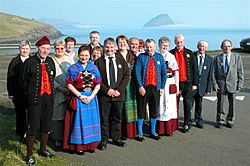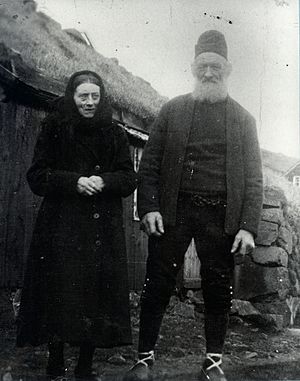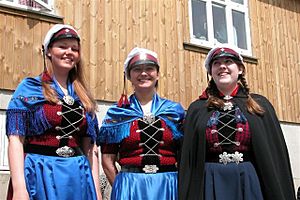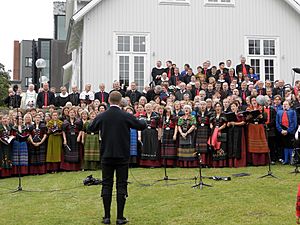Faroe Islanders facts for kids

Faroese folk dancers in national costumes
|
|
| Total population | |
|---|---|
| c. 70,000 | |
| Regions with significant populations | |
| ≈50,000 | |
| 21,687 | |
| 1,981 | |
| Languages | |
| Faroese, Danish (Gøtudanskt accent) | |
| Religion | |
| Lutheranism (Church of the Faroe Islands) Historically also the Norse religion and Roman Catholicism (1000–1538) |
|
| Related ethnic groups | |
| Danes, Norwegians, Swedes, Icelanders, Celts | |
The Faroese people or Faroe Islanders are a group of people who originally come from the Faroe Islands. They are known as føroyingar in Faroese and færinger in Danish. Their background is a mix of Norse (from Scandinavia) and Gaelic (from Ireland and Scotland) cultures.
Around 50,000 Faroese people live in the Faroe Islands today. Many others, about 21,000, live in nearby countries. Most of them live in Denmark, Iceland, and Norway. The Faroe Islands are a part of the Kingdom of Denmark.
The language spoken by the Faroese people is called Faroese. It is a North Germanic language. This means it is related to languages like Icelandic and some types of Norwegian.
Where the Faroese People Came From
The very first people known to settle the Faroe Islands were Gaelic hermits and monks. They arrived on the islands around the 6th century. These were religious people who wanted to live alone.
Later, starting in the 9th century, people known as Norse-Gaels arrived. They brought their Norse culture and language to the islands. These Norse-Gaels were a mix of Norse and Gaelic people.
Not much is known about this early period. However, an old Icelandic story called the Færeyinga saga tells us some things. This story was written around the year 1200. It talks about events that happened about 300 years before that time.
According to the saga, many Norse people left Norway. They did this because they did not agree with the Norwegian king's plan to unite the country. So, they sailed to other places, including the newly found islands in the west.
Historians believe that a Viking named Grímur Kamban was one of the first Norse settlers in the Faroes. It is likely that the Norwegians knew about the islands before they left Norway. Perhaps the Gaelic people from Scotland and Ireland had told them about the islands.
The name Grímur is an old Norse first name. But Kamban sounds like it comes from a Celtic background. This means Grímur might have been from Ireland, Scotland, or the Isle of Man. These were places where Vikings already had settlements. Some old place names on the Faroes also suggest that some settlers came from the Scottish islands or the British coast.
Scientists have studied the DNA of Faroese people. They found that the male family lines (Y chromosomes) are mostly from Scandinavia (87%). However, the female family lines (mitochondrial DNA) are mostly Celtic (84%). This shows the mixed heritage of the Faroese people.
See also
- List of Faroese people
- Demographics of the Faroe Islands
- Culture of the Faroe Islands
- Flag of the Faroe Islands
- Faroese Dane




